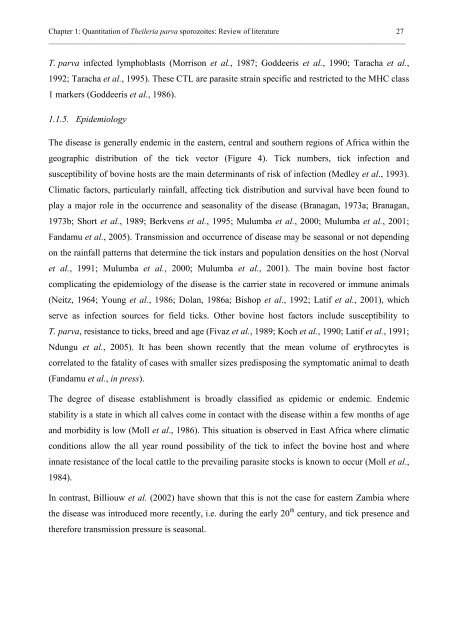In vitro quantitation of Theileria parva sporozoites for use - TropMed ...
In vitro quantitation of Theileria parva sporozoites for use - TropMed ...
In vitro quantitation of Theileria parva sporozoites for use - TropMed ...
Create successful ePaper yourself
Turn your PDF publications into a flip-book with our unique Google optimized e-Paper software.
Chapter 1: Quantitation <strong>of</strong> <strong>Theileria</strong> <strong>parva</strong> <strong>sporozoites</strong>: Review <strong>of</strong> literature 27<br />
______________________________________________________________________________________________<br />
T. <strong>parva</strong> infected lymphoblasts (Morrison et al., 1987; Goddeeris et al., 1990; Taracha et al.,<br />
1992; Taracha et al., 1995). These CTL are parasite strain specific and restricted to the MHC class<br />
1 markers (Goddeeris et al., 1986).<br />
1.1.5. Epidemiology<br />
The disease is generally endemic in the eastern, central and southern regions <strong>of</strong> Africa within the<br />
geographic distribution <strong>of</strong> the tick vector (Figure 4). Tick numbers, tick infection and<br />
susceptibility <strong>of</strong> bovine hosts are the main determinants <strong>of</strong> risk <strong>of</strong> infection (Medley et al., 1993).<br />
Climatic factors, particularly rainfall, affecting tick distribution and survival have been found to<br />
play a major role in the occurrence and seasonality <strong>of</strong> the disease (Branagan, 1973a; Branagan,<br />
1973b; Short et al., 1989; Berkvens et al., 1995; Mulumba et al., 2000; Mulumba et al., 2001;<br />
Fandamu et al., 2005). Transmission and occurrence <strong>of</strong> disease may be seasonal or not depending<br />
on the rainfall patterns that determine the tick instars and population densities on the host (Norval<br />
et al., 1991; Mulumba et al., 2000; Mulumba et al., 2001). The main bovine host factor<br />
complicating the epidemiology <strong>of</strong> the disease is the carrier state in recovered or immune animals<br />
(Neitz, 1964; Young et al., 1986; Dolan, 1986a; Bishop et al., 1992; Latif et al., 2001), which<br />
serve as infection sources <strong>for</strong> field ticks. Other bovine host factors include susceptibility to<br />
T. <strong>parva</strong>, resistance to ticks, breed and age (Fivaz et al., 1989; Koch et al., 1990; Latif et al., 1991;<br />
Ndungu et al., 2005). It has been shown recently that the mean volume <strong>of</strong> erythrocytes is<br />
correlated to the fatality <strong>of</strong> cases with smaller sizes predisposing the symptomatic animal to death<br />
(Fandamu et al., in press).<br />
The degree <strong>of</strong> disease establishment is broadly classified as epidemic or endemic. Endemic<br />
stability is a state in which all calves come in contact with the disease within a few months <strong>of</strong> age<br />
and morbidity is low (Moll et al., 1986). This situation is observed in East Africa where climatic<br />
conditions allow the all year round possibility <strong>of</strong> the tick to infect the bovine host and where<br />
innate resistance <strong>of</strong> the local cattle to the prevailing parasite stocks is known to occur (Moll et al.,<br />
1984).<br />
<strong>In</strong> contrast, Billiouw et al. (2002) have shown that this is not the case <strong>for</strong> eastern Zambia where<br />
the disease was introduced more recently, i.e. during the early 20 th century, and tick presence and<br />
there<strong>for</strong>e transmission pressure is seasonal.











